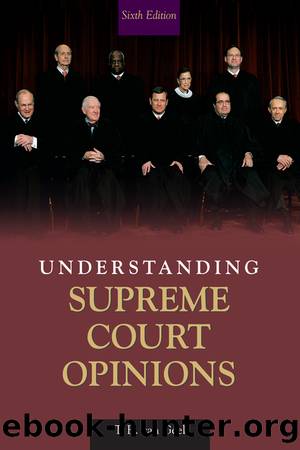Understanding Supreme Court Opinions by Tyll R. van Geel

Author:Tyll R. van Geel [Geel, Tyll R. van]
Language: eng
Format: epub
Tags: American Government, Political Science, Judicial Branch
ISBN: 9780321424105
Google: 86-RAAAAMAAJ
Goodreads: 103936
Publisher: Longman Publishing Group
Published: 1991-01-01T00:00:00+00:00
Establishment and Free Exercise Tests
Recall from Chapter 2 that the Supreme Court has struck a delicate balance between the establishment and free exercise clauses of the First Amendment. The Court has sought to strike this balance using certain tests. The derivation of the tests used in conjunction with the âestablishment clauseâ opinions has been the subject of much controversy both on and off the Court. The text, the framersâ intent, the theory and principles of the First Amendment, tradition, contemporary values, precedent, and practical considerations have all figured into the debate over the development, interpretation, and application of the tests. It is these debates that characterize many of the recent majority and dissenting opinions.
One set of tests in dispute in connection with the establishment clause are the so-called Lemon tests (the opinion in which they appeared was Lemon v. Kurtzman [1971]). To survive a challenge based on the establishment clause, (1) the policy must have a secular purpose; (2) its primary effect must be one that neither advances nor inhibits religion; and (3) the law must not foster excessive governmental entanglement with religion. Today the entanglement test has been collapsed into the second, primary effect test, as but one aspect of the inquiry into the primary effect of the policy (Agostini v. Felton [1997]).
Although the Court has stayed with the first and second test, over the years the interpretation, especially of the second test, has evolved. Thus in reading these establishment clause opinions one has to be sensitive to the particular version of the test being used in the case. Different justices use different versions of this same test, reflective of deep disagreements over the meaning of the establishment clause. Justice Souter believes the clause establishes a principle of âno aidâ to religion. But he recognizes that âthere is no pure aid to religion and no purely secular welfare benefitâ; hence the Courtâs task is to realistically assess the effect of a particular form of aid (Mitchell v. Helms [2000]). To that end, he says the Court needs to look at a number of factors: the evenhandedness of the aid, the type of aid recipient, the direct- or indirectness of the distribution, the content of the aid, its potential divertibility to religious purposes, the degree the aid supplants religious school expenses, and the substantiality of the aid. This version of the test places sharp limits on government aid.
Other justices who reject the âno aidâ principle offer a different interpretation of the test. Justice Thomas interprets the second test to mean that aid is permissible if it does not result in governmental indoctrination, does not define its recipients by reference to religion, or does not create excessive entanglement. As a practical matter Justice Thomas finds these elements are satisfied when the aid is offered on a neutral basis to both public and private schools (religious and nonreligious), and is secular in content (e.g., computer equipment). If it meets this test, even if the aid is diverted to religious purposes, the aid is permissible.
Download
This site does not store any files on its server. We only index and link to content provided by other sites. Please contact the content providers to delete copyright contents if any and email us, we'll remove relevant links or contents immediately.
Objection! by Nancy Grace(1762)
Apeirogon by Colum McCann(1675)
Anatomy of Injustice by Raymond Bonner(1640)
That Every Man Be Armed by Stephen P. Halbrook(1558)
Civil Procedure (Aspen Casebooks) by Stephen C. Yeazell(1532)
The Vaccine Court by Rohde Wayne(1488)
Injustices by Ian Millhiser(1479)
Storytelling for Lawyers by Meyer Philip(1439)
A Practical Guide to International Arbitration in London by Hilary Heilbron(1411)
Restitution by Restitution(1407)
Coercing Virtue by Robert H. Bork(1339)
Broken Scales by Joel Cohen(1334)
Tangled Webs: How False Statements Are Undermining America: From Martha Stewart to Bernie Madoff by James B. Stewart(1320)
The Tools of Argument: How the Best Lawyers Think, Argue, and Win by Joel Trachtman(1295)
A Matter of Interpretation by Antonin Scalia(1288)
INDEFENSIBLE: One Lawyer's Journey Into the Inferno of American Justice by Feige David(1268)
American Tragedy by Lawrence Schiller & James Willwerth(1259)
A Religious Orgy in Tennessee by H.L. Mencken(1234)
Tangled Webs by James B. Stewart(1231)
